Students’ Intention toward Artificial Intelligence in the Context of Digital Transformation
Abstract
:1. Introduction
2. Literature Review and Hypotheses Development
2.1. Students’ Intention toward AI
2.2. Conceptual Model and Hypotheses
3. Research Methodology
- indicator reliability (by examining outer loadings),
- internal consistency reliability (by examining Cronbach’s α and composite reliability (CR)),
- convergent validity (by examining the average variance extracted (AVE)), and
- discriminant validity (by examining Fornell–Larcker and HTMT criterion).
4. Results
5. Discussion
6. Conclusions
Author Contributions
Funding
Informed Consent Statement
Data Availability Statement
Conflicts of Interest
References
- Prentice, G.; Brady, J.; McLaughlin, C. Education Service Quality, Value and Satisfaction on Student Customer Intentions and Behaviour; DBS Library Press: Dublin, Ireland, 2018. [Google Scholar]
- Chawla, M. Customers’ (students’) perceptions about 7ps of higher education marketing mix. Asian J. Multidiscip. Stud. 2013, 1, 106–112. Available online: https://core.ac.uk/download/pdf/229675328.pdf (accessed on 13 January 2024).
- Russell, M. Marketing education: A review of service quality perceptions among international students. Int. J. Contemp. Hosp. Manag. 2005, 17, 65–77. [Google Scholar] [CrossRef]
- Faranda, W.T.; Clarke, T.B.; Clarke, I., III. Marketing student perceptions of academic program quality and relationships to surface, deep, and strategic learning approaches. J. Mark. Educ. 2021, 43, 9–24. [Google Scholar] [CrossRef]
- Teo, T.; Zhou, M. Explaining the intention to use technology among university students: A structural equation modeling approach. J. Comput. High. Educ. 2014, 26, 124–142. [Google Scholar] [CrossRef]
- Kaur, N.; Gopal, K. An assessment of students’ intention of technology acceptance for online education. J. Posit. Sch. Psychol. 2022, 6, 4563–4577. Available online: https://journalppw.com/index.php/jpsp/article/view/2127 (accessed on 15 January 2024.).
- Boucher, P. Artificial Intelligence: How Does It Work, Why Does It Matter, and What Can We Do About It? In European Parliamentary Research Service; European Parliament: Brussels, Belgium, 2020; Available online: https://www.europarl.europa.eu/RegData/etudes/STUD/2020/641547/EPRS_STU(2020)641547_EN.pdf (accessed on 18 January 2024.).
- Sing, C.C.; Teo, T.; Huang, F.; Chiu, T.K.; Wei, W.X. Secondary school students’ intentions to learn AI: Testing moderation effects of readiness, social good and optimism. Educ. Technol. Res. Dev. 2022, 70, 765–782. [Google Scholar] [CrossRef]
- Klopov, I.; Shapurov, O.; Voronkova, V.; Nikitenko, V.; Oleksenko, R.; Khavina, I.; Chebakova, Y. Digital Transformation of Education Based on Artificial Intelligence. TEM J. 2023, 12, 2625–2634. [Google Scholar] [CrossRef]
- Oliveira, K.K.S.; de Souza, R.A.C. Digital transformation towards education 4.0. Inform. Educ. 2022, 21, 283–309. [Google Scholar] [CrossRef]
- McCarthy, A.M.; Maor, D.; McConney, A.; Cavanaugh, C. Digital transformation in education: Critical components for leaders of system change. Soc. Sci. Humanit. Open 2023, 8, 100479. [Google Scholar] [CrossRef]
- Quy, V.K.; Thanh, B.T.; Chehri, A.; Linh, D.M.; Tuan, D.A. AI and digital transformation in higher education: Vision and approach of a specific university in Vietnam. Sustainability 2023, 15, 11093. [Google Scholar] [CrossRef]
- Chassignol, M.; Khoroshavin, A.; Klimova, A.; Bilyatdinova, A. Artificial Intelligence trends in education: A narrative overview. Procedia Comput. Sci. 2018, 136, 16–24. [Google Scholar] [CrossRef]
- Holmes, W.; Tuomi, I. State of the art and practice in AI in education. Eur. J. Educ. 2022, 57, 542–570. [Google Scholar] [CrossRef]
- Rahiman, H.U.; Kodikal, R. Revolutionizing education: Artificial intelligence empowered learning in higher education. Cogent Educ. 2024, 11, 2293431. [Google Scholar] [CrossRef]
- Pedró, F. Artificial Intelligence in Education: Challenges and Opportunities for Sustainable Development; UNESCO Education Sector: Paris, France, 2019. [Google Scholar]
- Aggarwal, D. Green Education: A Sustainable Development Initiative with the Power of Artificial Intelligence (AI). J. Image Process. Intell. Remote Sens. 2023, 3, 39–44. [Google Scholar] [CrossRef]
- Sohn, K.; Kwon, O. Technology acceptance theories and factors influencing artificial Intelligence-based intelligent products. Telemat. Inform. 2020, 47, 101324. [Google Scholar] [CrossRef]
- Huang, Y.-C. Integrated concepts of the UTAUT and TPB in virtual reality behavioral intention. J. Retail. Consum. Serv. 2023, 70, 103127. [Google Scholar] [CrossRef]
- Kim, J.; Erdem, M.; Kim, B. Adoption of in-room voice assistants: A cross-cultural study. J. Hosp. Tour. Insights 2023. ahead-of-print. [Google Scholar] [CrossRef]
- Balakrishnan, J.; Abed, S.S.; Jones, P. The role of meta-UTAUT factors, perceived anthropomorphism, perceived intelligence, and social self-efficacy in chatbot-based services? Technol. Forecast. Soc. Chang. 2022, 180, 121629. [Google Scholar] [CrossRef]
- Menon, D.; Shilpa, K. “Chatting with ChatGPT”: Analyzing the factors influencing users’ intention to Use the Open AI’s ChatGPT using the UTAUT model. Heliyon 2023, 9, e20962. [Google Scholar] [CrossRef]
- Chatterjee, S.; Rana, N.P.; Khorana, S.; Mikalef, P.; Sharma, A. Assessing Organizational Users’ Intentions and Behavior to AI Integrated CRM Systems: A Meta-UTAUT Approach. Inf. Syst. Front. 2023, 25, 1299–1313. [Google Scholar] [CrossRef]
- Kim, Y.J.; Choi, J.H.; Fotso, G.M.N. Medical professionals’ adoption of AI-based medical devices: UTAUT model with trust mediation. J. Open Innov. Technol. Mark. Complex. 2024, 10, 100220. [Google Scholar] [CrossRef]
- Horodyski, P. Recruiter’s perception of artificial intelligence (AI)-based tools in recruitment. Comput. Hum. Behav. Rep. 2023, 10, 100298. [Google Scholar] [CrossRef]
- Tanantong, T.; Wongras, P. A UTAUT-Based Framework for Analyzing Users’ Intention to Adopt Artificial Intelligence in Human Resource Recruitment: A Case Study of Thailand. Systems 2024, 12, 28. [Google Scholar] [CrossRef]
- Andrews, J.E.; Ward, H.; Yoon, J. UTAUT as a Model for Understanding Intention to Adopt AI and Related Technologies among Librarians. J. Acad. Librariansh. 2021, 47, 102437. [Google Scholar] [CrossRef]
- Cao, G.; Duan, Y.; Edwards, J.S.; Dwivedi, Y.K. Understanding managers’ attitudes and behavioral intentions towards using artificial intelligence for organizational decision-making. Technovation 2021, 106, 102312. [Google Scholar] [CrossRef]
- Ferri, L.; Maffei, M.; Spanó, R.; Zagaria, C. Uncovering risk professionals’ intentions to use artificial intelligence: Empirical evidence from the Italian setting. Manag. Decis. 2023. ahead-of-print. [Google Scholar] [CrossRef]
- Loske, D.; Klumpp, M. Intelligent and efficient? An empirical analysis of human–AI collaboration for truck drivers in retail logistics. Int. J. Logist. Manag. 2021, 32, 1356–1383. [Google Scholar] [CrossRef]
- Chai, C.S.; Wang, X.; Xu, C. An Extended Theory of Planned Behavior for the Modelling of Chinese Secondary School Students’ Intention to Learn Artificial Intelligence. Mathematics 2020, 8, 2089. [Google Scholar] [CrossRef]
- Chai, C.S.; Chiu, T.K.; Wang, X.; Jiang, F.; Lin, X.F. Modeling Chinese Secondary School Students’ Behavioral Intentions to Learn Artificial Intelligence with the Theory of Planned Behavior and Self-Determination Theory. Sustainability 2023, 15, 605. [Google Scholar] [CrossRef]
- Ayanwale, M.A. Evidence from Lesotho Secondary Schools on Students’ Intention to Engage in Artificial Intelligence Learning. In Proceedings of the 2023 IEEE AFRICON, Nairobi, Kenya, 20–22 September 2023; pp. 1–6. [Google Scholar] [CrossRef]
- Wang, F.; King, R.B.; Chai, C.S.; Zhou, Y. University students’ intentions to learn artificial intelligence: The roles of supportive environments and expectancy–value beliefs. Int. J. Educ. Technol. High. Educ. 2023, 20, 51. [Google Scholar] [CrossRef]
- Ayanwale, M.A.; Sanusi, I.T.; Adelana, O.P.; Aruleba, K.D.; Oyelere, S.S. Teachers’ readiness and intention to teach artificial intelligence in schools. Comput. Educ. Artif. Intell. 2022, 3, 100099. [Google Scholar] [CrossRef]
- Sanusi, I.T.; Ayanwale, M.A.; Chiu, T.K.F. Investigating the moderating effects of social good and confidence on teachers’ intention to prepare school students for artificial intelligence education. Educ. Inf. Technol. 2024, 29, 273–295. [Google Scholar] [CrossRef]
- Alzahrani, L. Analyzing Students’ Attitudes and Behavior toward Artificial Intelligence Technologies in Higher Education. Int. J. Recent Technol. Eng. 2023, 11, 65–73. [Google Scholar] [CrossRef]
- Chatterjee, S.; Bhattacharjee, K.K. Adoption of artificial intelligence in higher education: A quantitative analysis using structural equation modelling. Educ. Inf. Technol. 2020, 25, 3443–3463. [Google Scholar] [CrossRef]
- Ragheb, M.A.; Tantawi, P.; Farouk, N.; Hatata, A. Investigating the acceptance of applying chat-bot (Artificial intelligence) technology among higher education students in Egypt. Int. J. High. Educ. Manag. 2022, 8, 1–13. [Google Scholar] [CrossRef]
- Wu, W.; Zhang, B.; Li, S.; Liu, H. Exploring Factors of the Willingness to Accept AI-Assisted Learning Environments: An Empirical Investigation Based on the UTAUT Model and Perceived Risk Theory. Front. Psychol. 2022, 13, 870777. [Google Scholar] [CrossRef] [PubMed]
- Romero-Rodríguez, J.M.; Ramírez-Montoya, M.S.; Buenestado-Fernández, M.; Lara-Lara, F. Use of ChatGPT at university as a tool for complex thinking: Students’ perceived usefulness. J. New Approaches Educ. Res. 2023, 12, 323–339. [Google Scholar] [CrossRef]
- Yu, S. A Research on University Students’ Behavioral Intention to use New-generation Information Technology in Intelligent Foreign Language Learning. ACM Trans. Asian Low-Resour. Lang. Inf. Process. 2022, in press. [Google Scholar] [CrossRef]
- Le Dang, H. An analysis of the factors affecting intention to use artificial intelligence technology in learning: A case study of Hanoi students. AJMI-ASEAN J. Manag. Innov. 2020, 7, 1–16. Available online: https://ajmi.stamford.edu/index.php/ajmi/article/view/183 (accessed on 13 January 2024.).
- Buabbas, A.J.; Miskin, B.; Alnaqi, A.A.; Ayed, A.K.; Shehab, A.A.; Syed-Abdul, S.; Uddin, M. Investigating Students’ Perceptions towards Artificial Intelligence in Medical Education. Healthcare 2023, 11, 1298. [Google Scholar] [CrossRef]
- Almaraz-López, C.; Almaraz-Menéndez, F.; López-Esteban, C. Comparative Study of the Attitudes and Perceptions of University Students in Business Administration and Management and in Education toward Artificial Intelligence. Educ. Sci. 2023, 13, 609. [Google Scholar] [CrossRef]
- Venkatesh, V.; Morris, M.G.; Davis, G.B.; Davis, F.D. User acceptance of information technology: Toward a unified view. MIS Q. 2003, 27, 425–478. [Google Scholar] [CrossRef]
- Collins, C.J. The interactive effects of recruitment practices and product awareness on job seekers’ employer knowledge and application behaviors. J. Appl. Psychol. 2007, 92, 180–190. [Google Scholar] [CrossRef]
- Abubakar, F.M.; Ahmad, H.B. The moderating effect of technology awareness on the relationship between UTAUT constructs and behavioural intention to use technology: A conceptual paper. Aust. J. Bus. Manag. Res. 2013, 3, 14–23. [Google Scholar] [CrossRef]
- Abubakar, F.M.; Ahmad, H.B. Empirical Investigation of Moderating Effect of Technology Awareness in UTAUT. Niger. J. Manag. Technol. Dev. 2015, 1, 109–134. [Google Scholar]
- Daniali, S.M.; Barykin, S.E.; Zendehdel, M.; Kalinina, O.V.; Kulibanova, V.V.; Teor, T.R.; Ilyina, I.A.; Alekseeva, N.S.; Lisin, A.; Moiseev, N.; et al. Exploring UTAUT Model in Mobile 4.5 G Service: Moderating Social–Economic Effects of Gender and Awareness. Soc. Sci. 2022, 11, 187. [Google Scholar] [CrossRef]
- Al-Azizi, L.; Al-Badi, A.H.; Al-Zrafi, T. Exploring the factors influencing employees’ willingness to use mobile applications in Oman: Using UTAUT model. J. E-Gov. Stud. Best Pract. 2018, 2018, 553293. Available online: https://ibimapublishing.com/articles/JEGSBP/2018/553293/553293.pdf (accessed on 19 January 2024). [CrossRef]
- Statistical Office of the Republic of Serbia. Statistical Yearbook of the Republic of Serbia; Statistical Office of the Republic of Serbia: Belgrade, Serbia, 2021. Available online: https://publikacije.stat.gov.rs/G2021/PdfE/G20212054.pdf (accessed on 19 January 2024).
- Statistical Office of the Republic of Serbia. Statistical Yearbook of the Republic of Serbia; Statistical Office of the Republic of Serbia: Belgrade, Serbia, 2022. Available online: https://publikacije.stat.gov.rs/G2022/pdf/G20222055.pdf (accessed on 19 January 2024).
- Statistical Office of the Republic of Serbia. Statistical Yearbook of the Republic of Serbia; Statistical Office of the Republic of Serbia: Belgrade, Serbia, 2023. Available online: https://publikacije.stat.gov.rs/G2023/Pdf/G20232056.pdf (accessed on 19 January 2024).
- Hair, J.F.; Hult, G.T.M.; Ringle, C.M.; Sarstedt, M. A Primer on Partial Least Squares Structural Equation Modeling; Sage: Thousand Oaks, CA, USA, 2017. [Google Scholar]
- Raub, S.; Blunschi, S. The power of meaningful work: How awareness of CSR initiatives fosters task significance and positive work outcomes in service employees. Cornell Hosp. Q. 2014, 55, 10–18. [Google Scholar] [CrossRef]
- Becker, J.-M.; Cheah, J.-H.; Gholamzade, R.; Ringle, C.M.; Sarstedt, M. PLS-SEM’s most wanted guidance. Int. J. Contemp. Hosp. Manag. 2023, 35, 321–346. [Google Scholar] [CrossRef]
- Ilić, M.P.; Păun, D.; Popović Šević, N.; Hadžić, A.; Jianu, A. Needs and Performance Analysis for Changes in Higher Education and Implementation of Artificial Intelligence, Machine Learning, and Extended Reality. Educ. Sci. 2021, 11, 568. [Google Scholar] [CrossRef]
- Kuleto, V.; Ilić, M.; Dumangiu, M.; Ranković, M.; Martins, O.M.D.; Păun, D.; Mihoreanu, L. Exploring Opportunities and Challenges of Artificial Intelligence and Machine Learning in Higher Education Institutions. Sustainability 2021, 13, 10424. [Google Scholar] [CrossRef]
- Bucea-Manea-Țoniş, R.; Kuleto, V.; Gudei, S.C.D.; Lianu, C.; Lianu, C.; Ilić, M.P.; Păun, D. Artificial Intelligence Potential in Higher Education Institutions Enhanced Learning Environment in Romania and Serbia. Sustainability 2022, 14, 5842. [Google Scholar] [CrossRef]
- Chen, X.; Xie, H.; Hwang, G.-J. A multi-perspective study on Artificial Intelligence in Education: Grants, conferences, journals, software tools, institutions, and researchers. Comput. Educ. Artif. Intell. 2020, 1, 100005. [Google Scholar]
- Foffano, F.; Scantamburlo, T.; Cortés, A. Investing in AI for social good: An analysis of European national strategies. AI Soc. 2023, 38, 479–500. [Google Scholar] [CrossRef]
- Chan, C.K.Y. A comprehensive AI policy education framework for university teaching and learning. Int. J. Educ. Technol. High. Educ. 2023, 20, 38. [Google Scholar] [CrossRef]
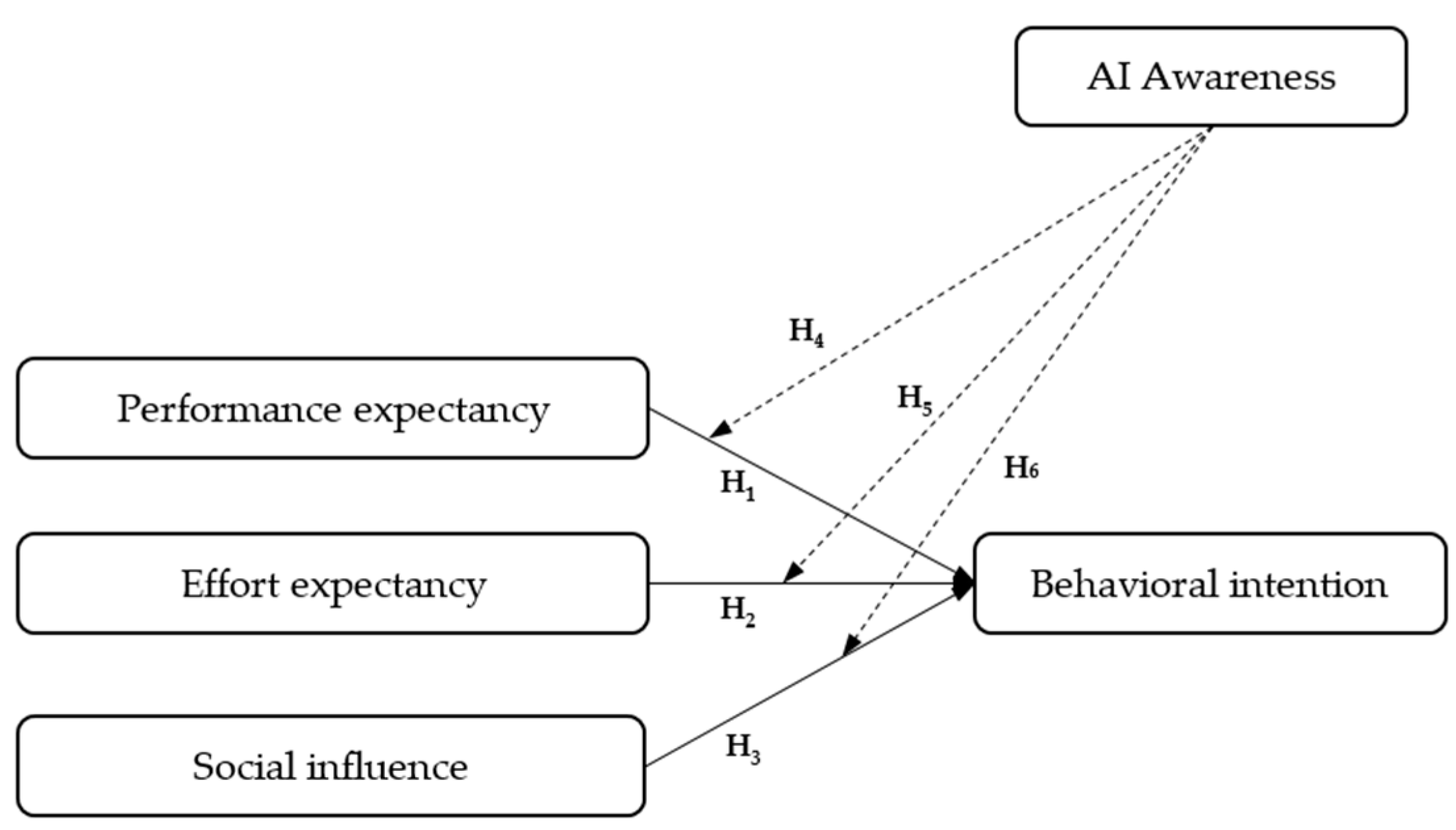
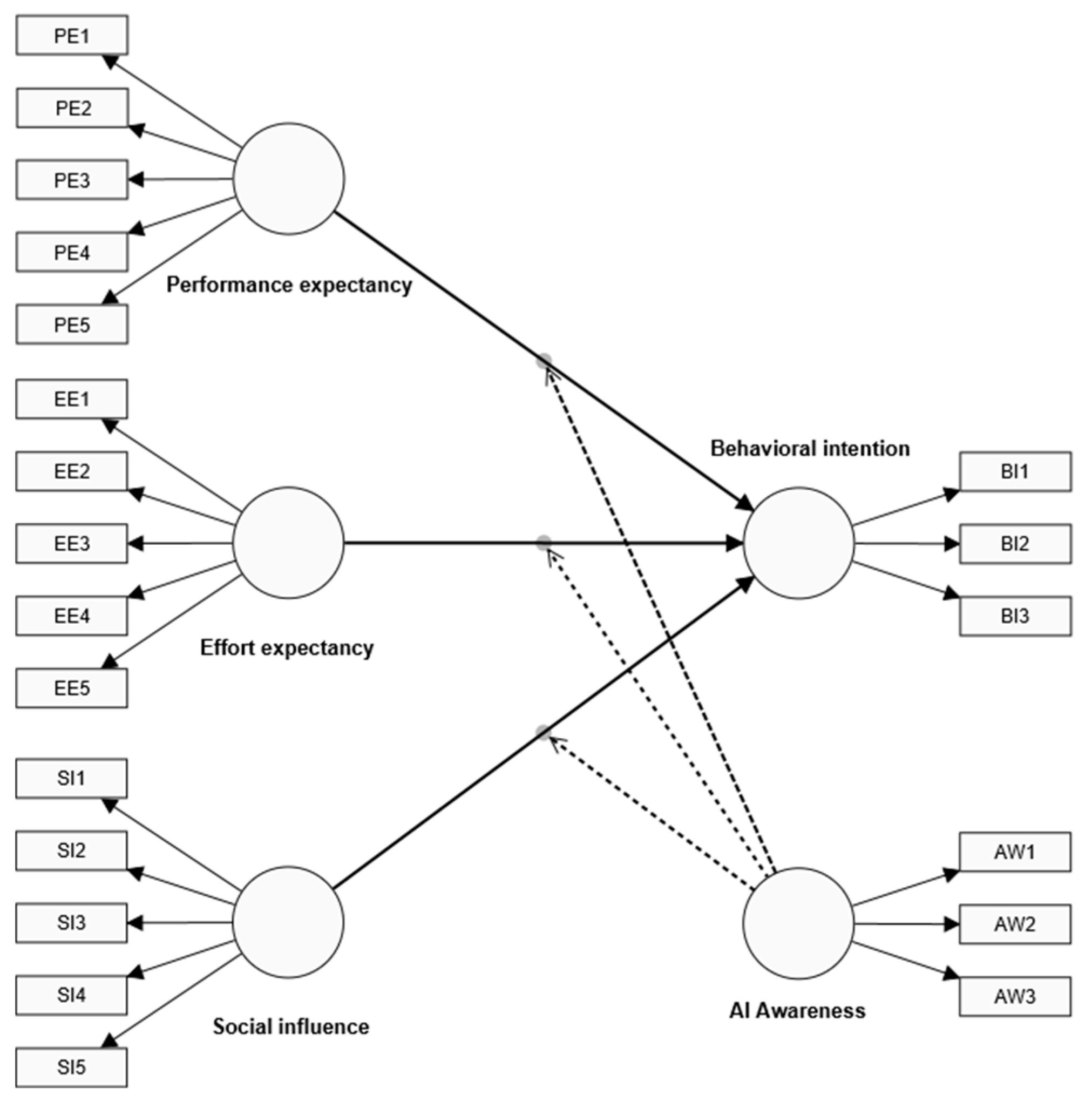
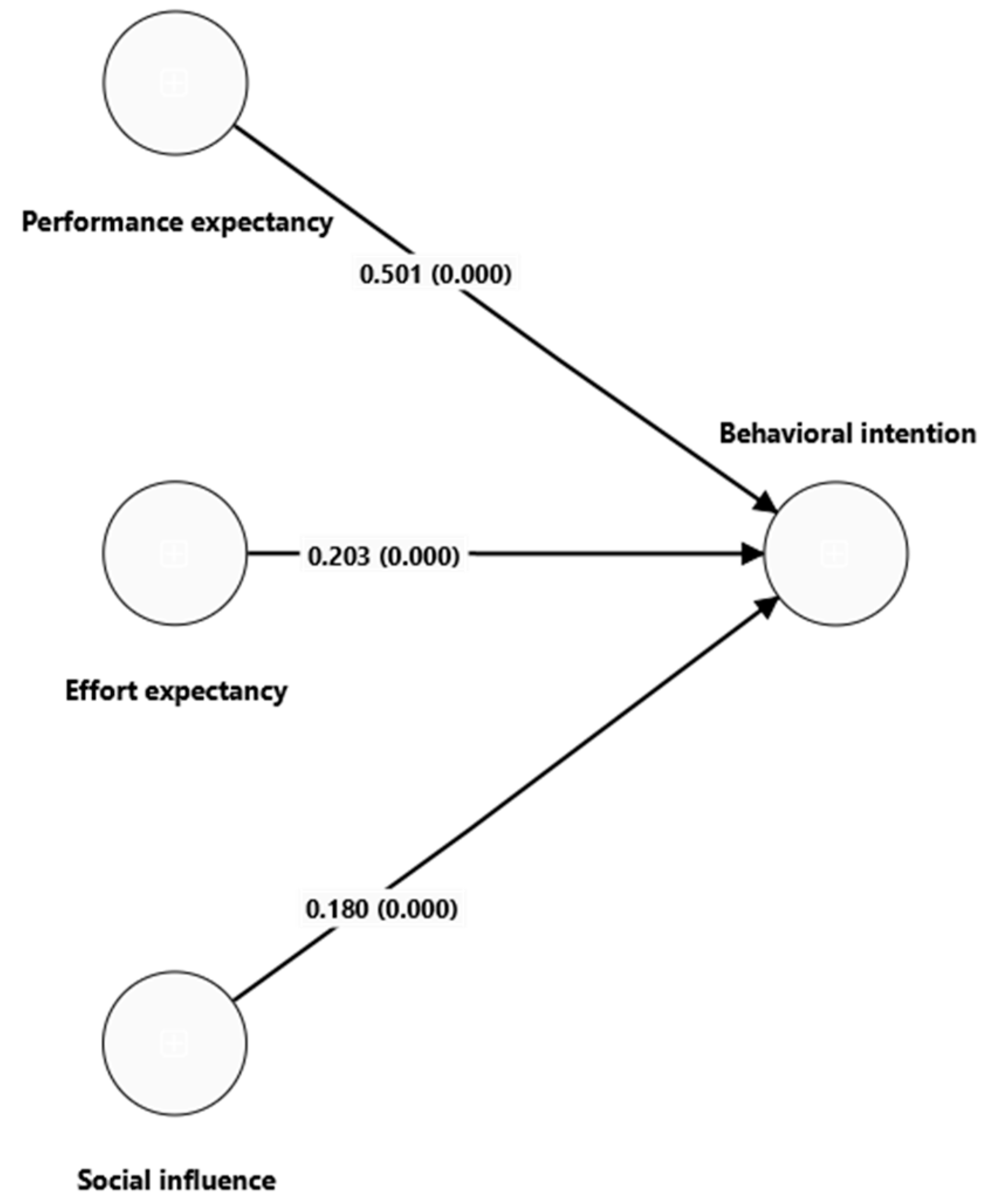
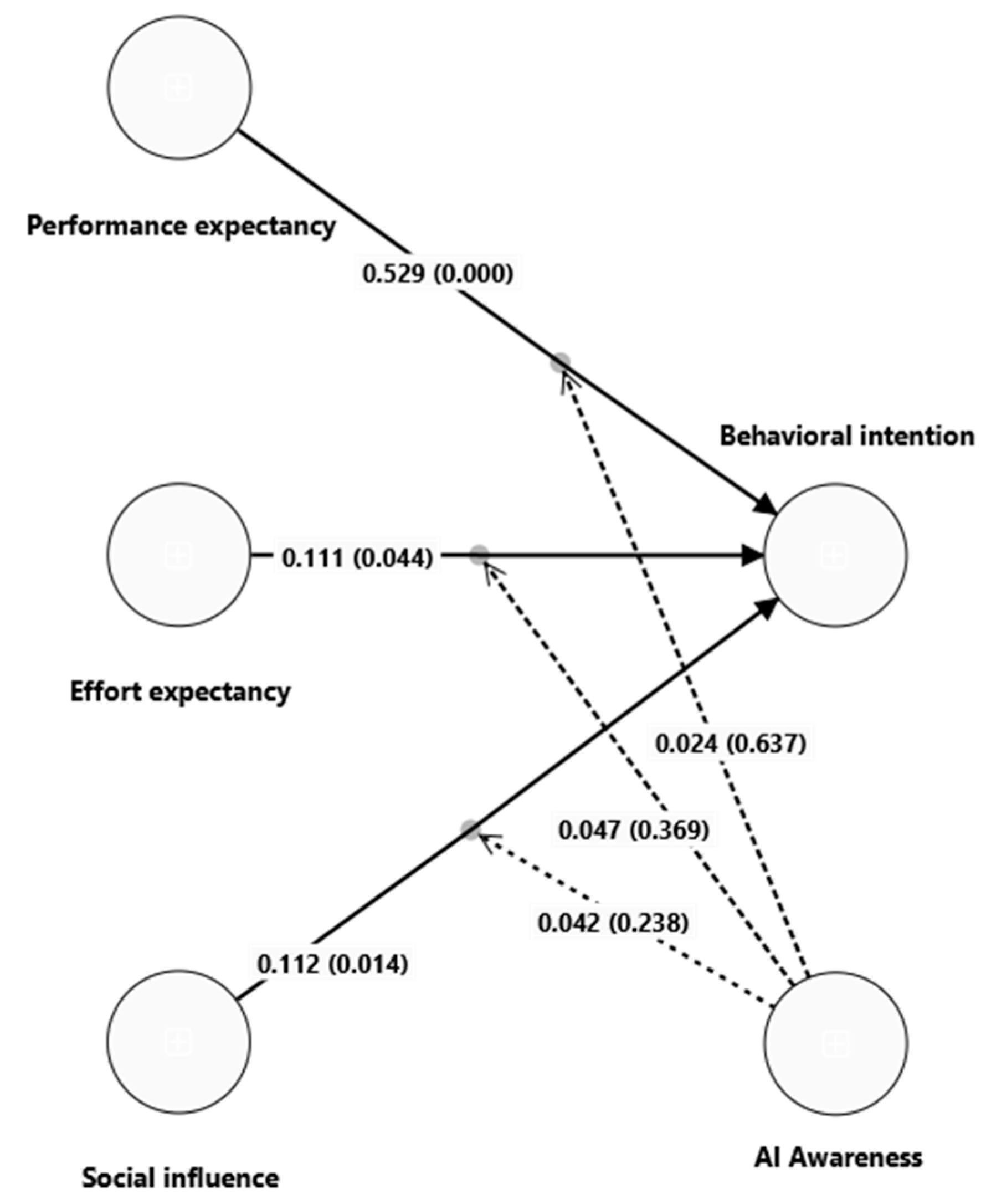
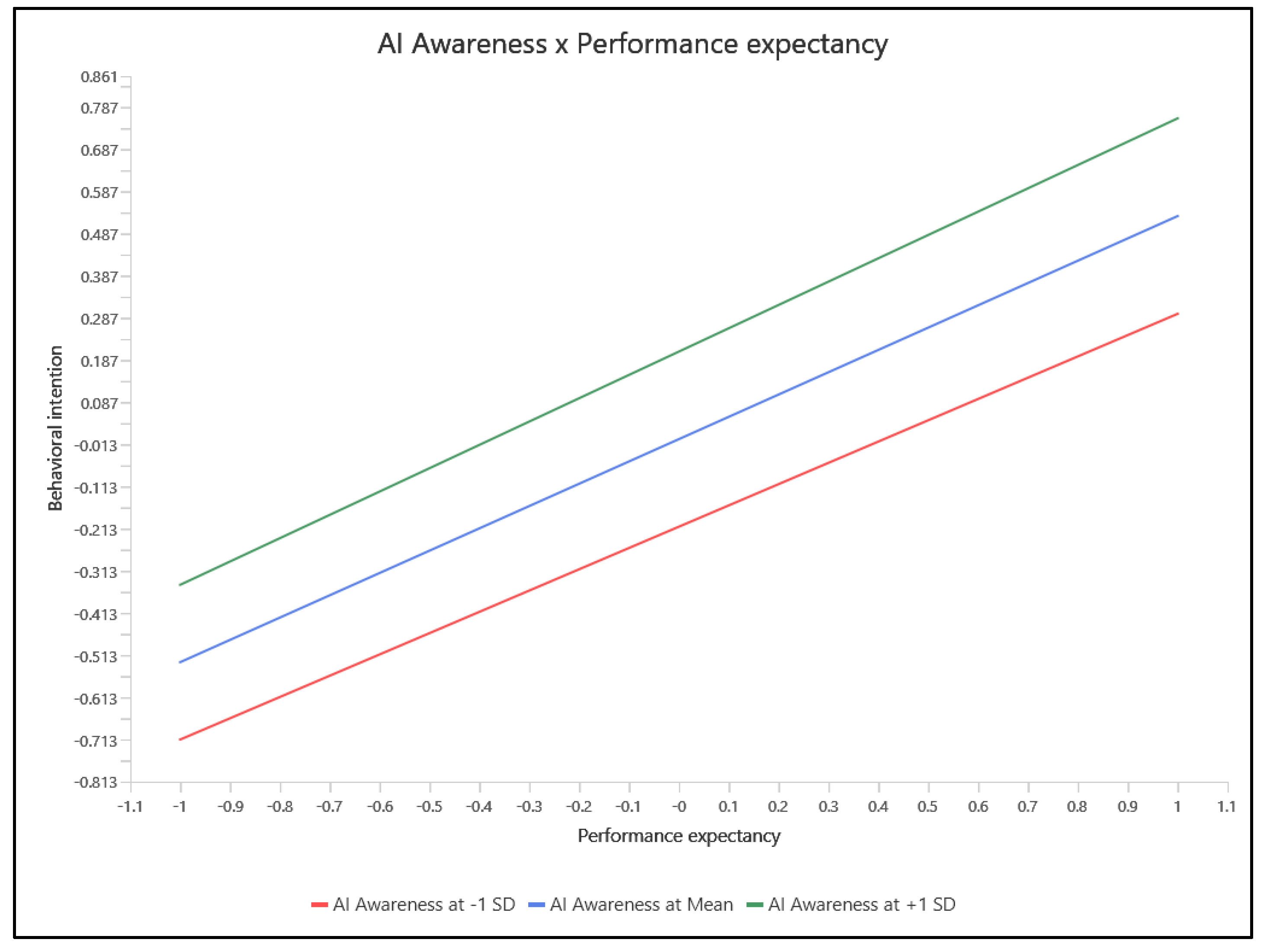

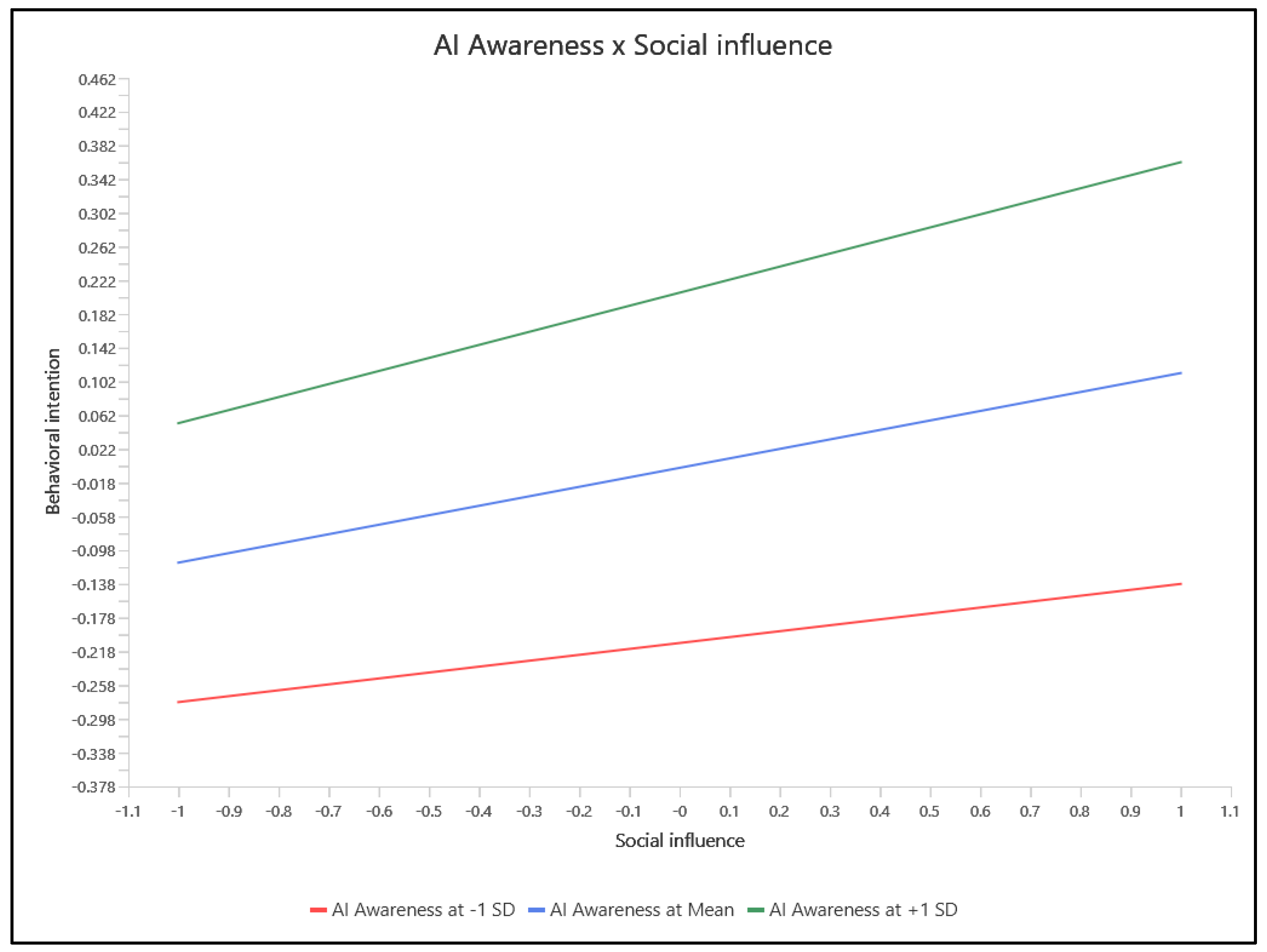
| Constructs and Items | Loadings | AVE | CR | Cronbach’s α |
|---|---|---|---|---|
| Performance expectancy | 0.700 | 0.921 | 0.893 | |
| PE1 | 0.841 | |||
| PE2 | 0.856 | |||
| PE3 | 0.838 | |||
| PE4 | 0.866 | |||
| PE5 | 0.780 | |||
| Effort expectancy | 0.668 | 0.909 | 0.875 | |
| EE1 | 0.783 | |||
| EE2 | 0.754 | |||
| EE3 | 0.851 | |||
| EE4 | 0.846 | |||
| EE5 | 0.846 | |||
| Social influence | 0.641 | 0.899 | 0.859 | |
| SI1 | 0.801 | |||
| SI2 | 0.729 | |||
| SI3 | 0.821 | |||
| SI4 | 0.854 | |||
| SI5 | 0.792 | |||
| Behavioral intention | 0.920 | 0.972 | 0.956 | |
| BI1 | 0.967 | |||
| BI2 | 0.971 | |||
| BI3 | 0.939 |
| BI | EE | PE | SI | |
|---|---|---|---|---|
| Behavioral intention (BI) | 0.959 | |||
| Effort expectancy (EE) | 0.569 | 0.817 | ||
| Performance expectancy (PE) | 0.694 | 0.593 | 0.837 | |
| Social influence (SI) | 0.457 | 0.379 | 0.400 | 0.800 |
| HTMT | |
|---|---|
| Effort expectancy <-> Behavioral intention | 0.620 |
| Performance expectancy <-> Behavioral intention | 0.747 |
| Performance expectancy <-> Effort expectancy | 0.665 |
| Social influence <-> Behavioral intention | 0.504 |
| Social influence <-> Effort expectancy | 0.437 |
| Social influence <-> Performance expectancy | 0.457 |
Disclaimer/Publisher’s Note: The statements, opinions and data contained in all publications are solely those of the individual author(s) and contributor(s) and not of MDPI and/or the editor(s). MDPI and/or the editor(s) disclaim responsibility for any injury to people or property resulting from any ideas, methods, instructions or products referred to in the content. |
© 2024 by the authors. Licensee MDPI, Basel, Switzerland. This article is an open access article distributed under the terms and conditions of the Creative Commons Attribution (CC BY) license (https://creativecommons.org/licenses/by/4.0/).
Share and Cite
Milicevic, N.; Kalas, B.; Djokic, N.; Malcic, B.; Djokic, I. Students’ Intention toward Artificial Intelligence in the Context of Digital Transformation. Sustainability 2024, 16, 3554. https://doi.org/10.3390/su16093554
Milicevic N, Kalas B, Djokic N, Malcic B, Djokic I. Students’ Intention toward Artificial Intelligence in the Context of Digital Transformation. Sustainability. 2024; 16(9):3554. https://doi.org/10.3390/su16093554
Chicago/Turabian StyleMilicevic, Nikola, Branimir Kalas, Nenad Djokic, Borka Malcic, and Ines Djokic. 2024. "Students’ Intention toward Artificial Intelligence in the Context of Digital Transformation" Sustainability 16, no. 9: 3554. https://doi.org/10.3390/su16093554









